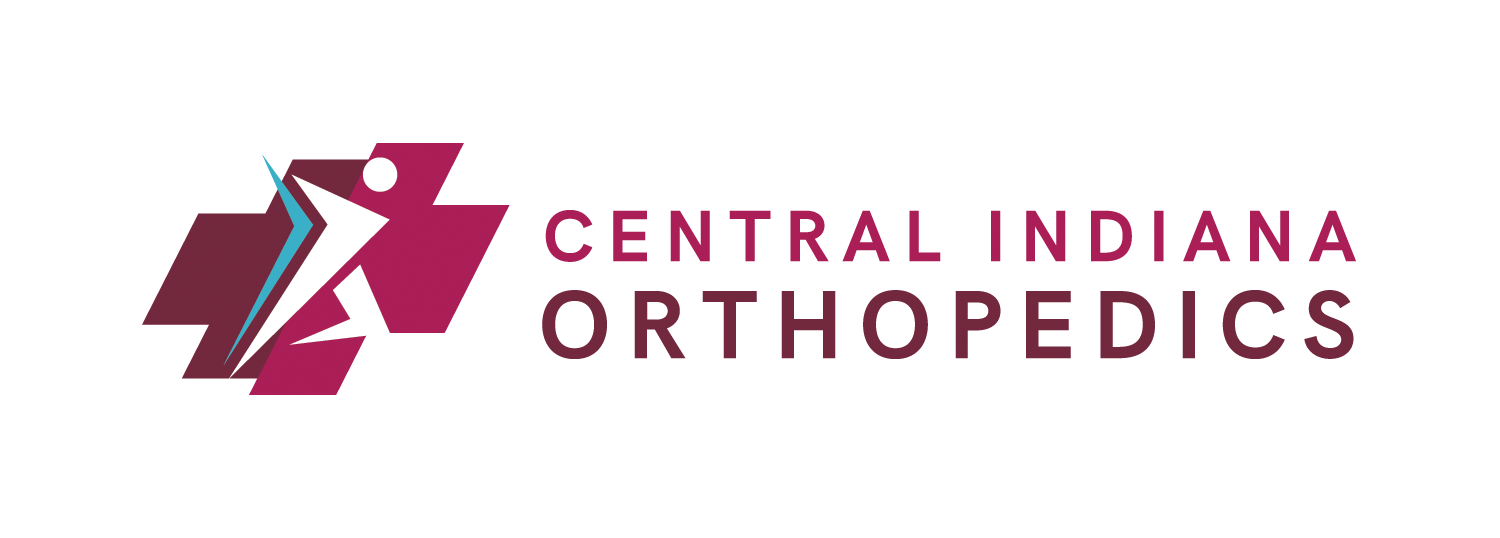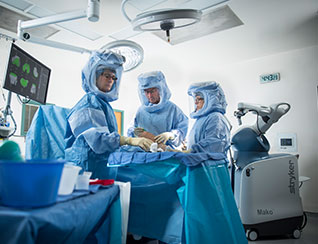Central Indiana Orthopedics is proud of its leadership in providing state-of-the-art and personalized care to all of our patients. We were the first orthopedic practice in the region to utilize Mako™ robotic-arm assisted technology.
Mako™ robotic technology, or Mako SmartRobotics™, is an innovative solution for many suffering from painful arthritis of the knee or hip and enables our patients to have a more predictable experience when undergoing joint replacement surgery. As with any new technology, our patients have a lot of questions about it. Below, we’ve put together a list of our most popular questions about Mako robotic technology – read on to get to know Mako.
What are the benefits of Mako robotic joint replacement?
The main benefits include:
1. Implants are placed in a perfect anatomic position for each patient, enabling better post-surgical movement and flexibility
2. The surgeon is able to cut less bone, which causes fewer trauma and reduced risk of surgical complications
3. With fewer trauma, the patient typically experiences less pain, uses less pain medication and in general recovers quicker
What procedures can be performed with Mako robotic technology?
Mako robotic technology is for total hip and total/partial knee replacement.
What conservative treatments are available to try before joint replacement surgery?
Conservative treatments to consider before surgery include oral anti-inflammatories, such as Tylenol, joint steroid injections and physical therapy.
What training is required for a surgeon to become certified in Mako robotic technology?
Every surgeon who wants to operate using Mako robotic technology must complete additional training, which typically includes hands-on training in a lab operating on cadavers, and completing classwork. Most importantly, a surgeon who is certified in Mako robotic technology is already a trained joint replacement surgeon and performs numerous traditional joint replacements per year.
What surgeons at Central Indiana Orthopedics are certified to perform Mako robotic procedures?
The following board-certified orthopedic surgeons are certified in Mako technology: Drs Kerry Bennett, Brian Camilleri, Ryan Cieply, Brent Damer, David Graybill, Joseph Jerman, P. Jamieson Kay, Salil Rajmaira, Thomas Salsbury and Nimu Surtani
Does the robot actually perform the surgery?
No. The surgeon operates the robot while the robot guides the surgeon’s cuts. During surgery, the surgeon references a computer screen as a guide. The robot will not allow the surgeon to operate outside of the pre-determined boundary.
What is the process of a Mako robotic procedure?
It is a complex process. First, we obtain a CT scan of the affected joint prior to surgery, which allows the surgeon to have an exact 3D replica of the affected joint. That CT data is loaded into the robot prior to surgery for the surgeon to plan the procedure. Once in surgery and the joint has been exposed, the surgeon uses a process called registration, which links the patient’s anatomy live to the CT scan loaded in the computer. It involves touching the bone around the joint in about 40-50 spots with a small device that the robot can see, and registering those points. The points on the bone that have been identified tell the robot more about the patient’s unique anatomy. The surgeon is able to see virtually where to make cuts, position components, etc., before actually starting the procedure. So, that’s what allows the surgeon to get the components in the perfect position, resulting in a safer procedure and minimal release of soft tissues.
How do the risks compare between Mako robotic joint replacement and a traditional joint replacement?
Essentially, the risk profile is the same between a robotic procedure and traditional joint replacement procedure.
What is considered a successful result?
With any joint replacement, we would consider a successful result to be a happy patient. Our goal is for the patient to return to the activities they loved doing prior to when the joint became arthritic and painful.
What can I expect during recovery from a Mako joint replacement?
Although every individual is unique and every treatment plan is different, general recovery times include in-hospital recovery for 1-4 days (unless it’s performed as outpatient), daily activities may be resumed 3-6 weeks following surgery and recovery to full activity is 6-12 months.
What activities can I participate in after joint replacement?
Activities that place excessive stress on the replaced joint should be avoided, such as skiing, running, contact sports, basketball and jumping.
Can the procedure be performed as outpatient?
Absolutely. We’ve been performing outpatient joint replacement procedures for approximately four years. CIO has a Mako robot in both our Muncie and Fishers surgery centers. Additionally, we perform Mako robotic joint replacement procedures at Ascension St. Vincent Fishers Hospital.
Is there an additional charge to insurance for Mako robotic procedure?
Patients will not see any additional charge for the Mako procedure, as it is charged the same as a traditional joint replacement.
How will I know I’m ready for surgery?
At CIO, we tell our patients – when you’re ready to get your joint replaced, you’ll know. You’ll be miserable enough that you just can’t stand it. You’ll find yourself avoiding things you really like to do, such as walking significant distances, stair climbing, trouble with sleep, stopping hobbies. We understand that surgery can be a difficult decision, so we let the patient make that decision, which typically comes after conservative treatment has already been tried. Our goal with any surgery is to get the patient back to what they loved doing before the joint became arthritic and painful.
How can I learn more or schedule an appointment?
If you are interested in learning more about Mako robotic technology, visit ciocenter.com/mako/. To schedule an appointment, call 800-622-6575 or Chat with us at ciocenter.com.

